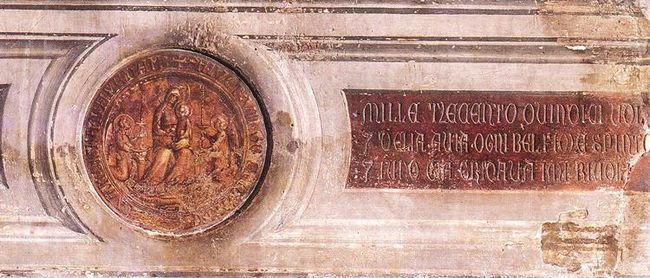Guccio di Mannaia
This article, Guccio di Mannaia, has recently been created via the Articles for creation process. Please check to see if the reviewer has accidentally left this template after accepting the draft and take appropriate action as necessary.
Reviewer tools: Inform author |
 Comment: Still not significant enough for actual notability. SwisterTwister talk 23:31, 2 January 2017 (UTC)
Comment: Still not significant enough for actual notability. SwisterTwister talk 23:31, 2 January 2017 (UTC)
SwisterTwister talk 23:31, 2 January 2017 (UTC)
- Hi, SwisterTwister, and thanks for reviewing my article. I thought that it would be approved, if only because there are pages about the person on both the French and Italian wikipedia sites (and though both are clearly in need of some work, neither page indicates that notability is an issue) as well as the Italian Treccani Biographical Dictionary, and he even has a a World Cat [1] reference as brought to my attention by Fraenir (talk). In any case, I will continue to expand the notability aspect of the biography as the burden is on me to make the case, and review the references as indicated for the sake of verifiability. Hopefully by next week it will be ready to resubmit. Cordially, TimeForLunch (talk) 09:22, 3 January 2017 (UTC)
Guccio di Mannaia (Malnaia; Malnaggia; Manaie; Mannaie) was an Italian goldsmith from Siena, Italy active from 1288 to 1318. He is best known for a 13th-century decorated gold-plated chalice, widely considered a masterpiece, which contains the first documented use of translucent enamels using the technique known as basse-taille.[1][2]
Life and works
Little is known about the life of Guccio di Mannaia, and very few works are attributed to him with certainty. He came from a family of Sienese goldsmiths, with his brother as well as his three sons working in the same trade.[3] He created four seals from 1292 to 1318 for which receipts of payment exist, and although one of these works is now lost the other three survive. He was well known in his city of origin, and received numerous official commissions.[3] An image from one of his seals, that of the rulers of Siena known as the Signori Nove, was reproduced by Simone Martini in his grand Maesta,[3] a fresco that covers an entire wall in the Palazzo Publicco of Siena. In addition, his work would anticipate that of Pietro and Ambrogio Lorenzetti.[4]
Guccio di Mannaia's only signed work is a chalice "of extrordinary importance and quality"[2] made in 1288-1292 at the request of Pope Nicholas IV for the Basilica of Saint Francis in Assisi. Made of gold-plated silver and decorated with ninety-six translucent and semi-translucent enamels, it is considered a masterpiece for both its iconographic and technical elements.[4] It was made using the lost-wax method and contains technical details including finely wrought repoussé leaves with other metalwork features that mark it as "Tuscan Gothic";[1] its form is said to be "highly influential, and it was never technically superseded".[5] The enamels depict images of the crucifiction, the Virgin and child, symbols of the evangelists, several Franciscan saints (Saints Francis, Clare, and Anthony), Pope Nicholas himself, as well as angels, apostles, and prophets. The range of enamel colors includes azure, violet, yellow-gold, green, brown, and blue, and in various places the chiselling and engraving of the metalwork reveals the silver underneath the gold plating.[6] His signature (Guccius Mannaie de Senis fecit) as well as the name of the commissioning Pope (Niccholaus Papa quartus) are contained in sixteen of the enamels that circumscribe the chalice’s stem. Commissioned by the first Franciscan pope, the chalice with its imagery is part of the vast decorative project that includes the frescos and stained glass windows of the Basilica. An inventory from 1430 of the Basilica, where the chalice is still kept, contains a reference to a now lost paten that was decorated with a scene of the Last Supper, similar in style to the chalice.[2] Guccio di Mannaia's work would inflence many other goldsmiths of the era, and his chalice would become a "fundamental model for the production of chalices in the decades to come."[2] Tondino di Guerrino, another goldsmith from Siena, probably studied under him as an apprentice.
Other works attributed to him are done so based only on comparison to the chalice rather than other documentary evidence, and can be found in museums in Florence, Siena, Paris, and Berlin.[5]
Category:Goldsmiths Category:13th century in art Category:Medieval art
References
- ^ a b Hourihane, Colum (2012-12-06). The Grove Encyclopedia of Medieval Art and Architecture. Vol. 1. OUP USA. p. 93. ISBN 9780195395365.
- ^ a b c d Metropolitan Museum of Art (New York, N.Y.) (1999-01-01). Morello, Giovanni (ed.). Splendori Di Assisi. Capolavori Dal Museo Della Basilica Di San Francesco. Catalogo Della Mostra (1998-99). Ediz. Inglese. Electa. p. 182. ISBN 9788843569328.
- ^ a b c Donato, Maria Monica (2012). Donato, Maria Monica (ed.). "Siena e artisti senesi: Maestri Orafi" (PDF) (in Italian). p. 19. Retrieved 2 January 2017.
- ^ a b Liscia Bemporad, Dora (1980). "Oreficerie e Avorio". In Ciardi Dupré dal Poggetto, Maria G. (ed.). Il Tesoro della Basilica di San Francesco ad Assisi. Assisi: Editrice Francescana. p. 125.
Few works of art ... achieve such a level of consistency among formal, decorative, iconographic and functional elements. / Poche opere d'arte ... raggiungono una tale coerenza tra l'elemento formale, decorativo, iconografico e funzionale.
- ^ a b Campbell, Gordon (2006-01-01). The Grove Encyclopedia of Decorative Arts. Vol. 1. Oxford University Press. p. 457. ISBN 9780195189483.
- ^ De Chirico, Fabio (2014). "Introduzione". In Callori di Vignale, Flavia; Santamaria, Ulderico (eds.). Il Calice di Guccio di Mannaia (in Italian). Città del Vaticano: Edizioni Musei Vaticani. p. 11. ISBN 9788882713300.
This article, Guccio di Mannaia, has recently been created via the Articles for creation process. Please check to see if the reviewer has accidentally left this template after accepting the draft and take appropriate action as necessary.
Reviewer tools: Inform author |


